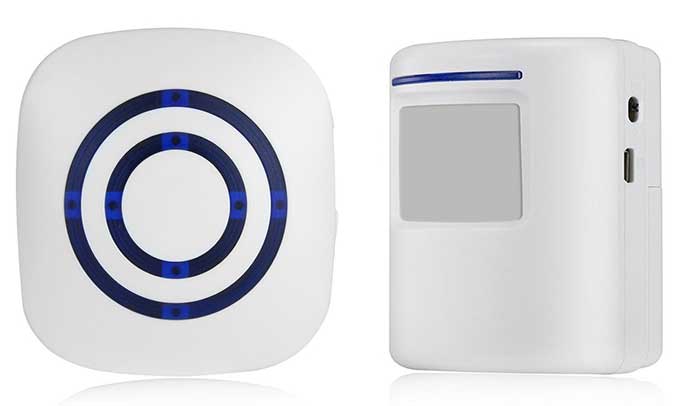Wireless Welcome Alert Doorbell

Works as a driveway alert, doorbell, home security alarm, and entry alert
The Wireless Welcome Alert Doorbell: Infrared Motion Sensor Alarm Chime consists of two units. One is a three-AAA-battery-powered (or USB-powered) infrared motion detector unit. It transmits a radio signal when it detects motion by a warm body. At the same time a little red light flashes to indicate that a transmission has occurred. To test its batteries, one moves a hand near it and watches to see if the red light still flashes. It has an on/off slider switch; it should be turned off during installation. I asked the seller what the battery life is, but got the nonsensical response that “Our doorbell did not contain battery.” This suggests to me that the seller isn’t the manufacturer. When I asked that question on the Q-and-A section on Amazon, I got one response, saying that he’d had his installed and working for four months. Probably batteries in a unit that sends fewer alerts, like one in a residential location, would last longer than one in a busy shop.
The other component is a plug-in receiver that sounds a little tune when a signal is emitted by the detector. It has three buttons: #1 turns the sound on/off, leaving only a blinking light to function as an alert. #2 selects from one of 38 tunes. (If none is selected, a default is used.) #3 adjusts the music volume to either High, Middle, or Low. One Amazon commenter said that these will reset to their defaults if there is a power outage, or if the Receiver is moved from one room to another. The detector’s sensing distance is 10–23 feet. The maximum range between units is 70 meters (or 328 feet).
Both units should be three feet above the ground. The maker recommends mounting the detector out of the wind. So I installed mine on the underside of the ceiling of my porch, pointing downward, a few inches away from a crosspiece in front of the top of the porch whose lower edge is a protective four inches below the ceiling. Pointing the sensor downward or backward (toward the door) also avoids picking up “noise” like people walking along the sidewalk. I now know immediately when the mail arrives or a package is delivered. I don’t have to visually check repeatedly to see if the mail has arrived. Neither do I need to worry about possible package theft, because many delivery people don’t ring the bell. (In fact, some visitors or solicitors fail to do so, too.) I may install additional units in some of my mini-sheds out back, using different tunes for each of them. (Or inside my car, as one Amazon reviewer is doing.) If I install many, I’ll need to use a power strip for the Receivers, plus, perhaps, one of the clever space-saving gadgets on this site listed by searching here for “wall wart”. The price is right ($17) and the units seem well constructed.
Note: The instruction sheet fails to mention how to mount the detector, which is too bad because it’s not obvious. First, the long screw is screwed in so its head is about 1/4 inch above the surface. Then the wide end of the keyhole slot in the plastic mounting plate is pushed over it, the plate then being slid to the narrow end of the keyhole. Third, the hole in the plate into which to insert the small screw is marked by either a marker or a pilot dent by a pointed object. Fourth, the plate is rotated away from that mark and a hole is drilled at the mark. Fifth, the plate is rotated back so its hole is aligned with the drilled hole and the small screw is inserted. Finally, the large screw is tightened down. This method ensures that the two drilled holes are perfectly aligned with the mounting plate. Now the ball of the ball-plate is inserted into the ball socket on the mounting plate. Lastly, the sliding slab on the other end of the ball-plate is slid into the slot for it on the Detector unit. This set-up means that the detector can be pointed easily in any direction, and that it can easily be removed from its mount (by sliding it out) for a battery change.
11/30/17Wireless Welcome Alert Doorbell ($17)









